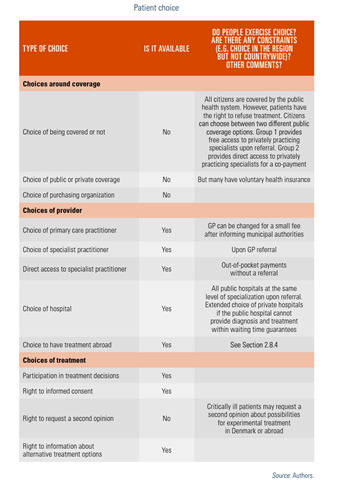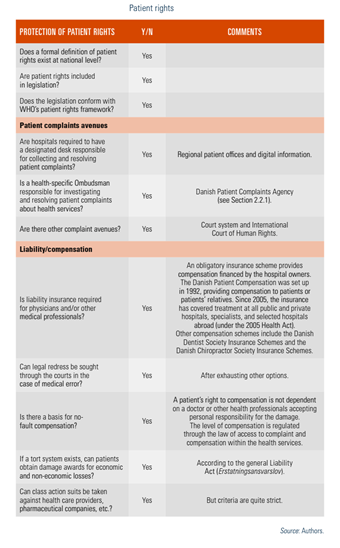-
22 May 2024 | Policy Analysis
New rules to ensure better protection for healthcare personnel-May 2024
2.8. Person-centred care
2.8.1. Patient information
The Danish Health Act (2005) covers the patient’s right to continuous information, adapted according to age and the diagnosis, given throughout examinations and treatment. Furthermore, the rules also determine doctors’ rights to share information with third parties, give patients the right to access documents, hold case records and that their confidentiality is maintained.
Patients can obtain information and guidance on hospital choice and waiting times through their GP and through patient offices, which exist in every region (see Table2.2). The Danish Health Authority, Danish Regions and the Ministry of Health have established several websites and digital portals to provide information to patients, such as the E-journal, health records (Sundhedsjournal) and Medicine card (Medicinkort). The digital portal eSundhed.dk gives access to individual patient data for patients and health care professionals and provides information about public and private hospitals, specialists and clinics. The portal also provides information about waiting times and quality indicators (see section 4.1.3).
Table2.2
In case of hospital referral, the hospital must send a notice letter to the patient, informing the patient of their specific examination and treatment. The hospital also provides information on its capacity to examine and treat the patient within one month (see section 2.8.2).
Since July 2018, refugees and migrants who have resided in Denmark for more than three years must pay a fee for interpreter services themselves.
National surveys show that up to half of nurses feel uneasy about having their full name appear in medical records. Further, nearly one-third fear that they or their families might be approached or harassed during their free time [1, 2].
To address these concerns, the government has proposed new rules to provide healthcare personnel with better opportunities to conceal their names in medical records and log information on platforms such as sundhed.dk, protecting them from patients and citizens who have harassed or threatened them. As a result, these specific patients will not be able to see the names of their healthcare personnel when accessing their personal health information about medications, vaccinations, or appointments [2].
The measure aims to offer better protection against violence, threats, and harassment of healthcare personnel. The proposed new rules, currently in public consultation, will mean that healthcare personnel’s names can be hidden for 90 days, with the possibility of an extension [2].
Authors
2.8.2. Patient choice
Since 1973, residents over the age of 15 have been able to choose between two coverage options in the statutory health system, known as Group 1 and Group 2. The default is Group 1 and almost all citizens belong to this group (see Table2.3). In Group 1, members are registered with a GP of their choice, practising within 15 km of their home (5 km in the Copenhagen area) or further if the patient moves after registration, provided they waive their right to home visits by the GP. Group 1 members have free access to emergency services and general preventive, diagnostic and curative services. Without a prior referral, patients may consult dentists, chiropractors, ear, nose and throat specialists or ophthalmologists. Their GP must refer them for access to all other medical specialties, physiotherapy and hospital treatments. Consultation with a GP or specialist is free, while dental care, podiatry, psychology consultations, chiropractic and physiotherapy are subsidized in most cases. Patients seeking care from specialists other than ear, nose and throat or ophthalmologists without a GP referral are liable to pay the full fee. In Group 2, individuals can consult any GP and specialist without a referral. The region will subsidize expenses up to the cost of the corresponding treatment for a patient in Group 1. The same rules apply to treatment by podiatrists, psychologists, dentists, chiropractors and physiotherapists. There is no charge for treatment in hospital. Only a minority of the population (1%) chooses this group, probably because of general satisfaction with the referral system (see section 5.2).
Table2.3
Most hospitals in Denmark are general hospitals. There are very few specialized hospitals other than psychiatric hospitals. Legislative reform in 1993 gave patients the freedom to choose to be treated at any hospital in the country if treatment takes place at the same level of specialization. Since 2003, direct referral to highly specialized services can be made by a medical doctor, wherever they work. According to a national study of choice behaviour, patients prefer treatment close to their place of residence (Birk & Henriksen, 2003).
A waiting time guarantee for diagnosis (30 days) and treatment (additional 30 days) has been in place for several years. If the regions cannot offer treatments at their hospitals within these time limits, they must inform patients of the right to seek treatment in other public or private hospitals at the expense of the home region. There are stricter waiting time guarantees for specific cancer procedures and procedures for certain other diseases (including coronary heart disease). If the hospital cannot treat the patient locally within the guarantee, it must look nationally or internationally for alternative hospitals. If this is not possible, the Danish Health Authority is involved to find an alternative solution.
2.8.3. Patient rights
The Danish Health Act specifies the basic and general principles of the individual patient’s right to self-determination and safety regarding the health system and medical examination, treatment and care (Table2.4).
Table2.4



